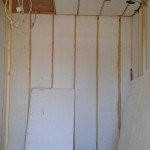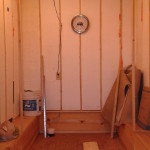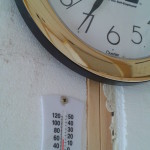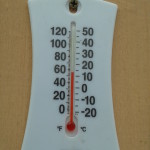With winter in full swing, getting the insulation in place became reaaaaalllly important. I was already too late, but pushing onward. I had acquired several sheets of 4′ x 8′ 3/4″ styrofoam panels. I found that if I doubled them up to 1-1/2″, they just fit into the wall panels. Though it took me a while to realize that if I cut them a shade wider than necessary, they would hold themselves into those spaces.
 Starting at the front I filled in the walls, then ceilings. Styrofoam is not the cleanest material to cut, leaving those feather-light little pieces all over to be blown about by the lightest breeze. I tried with some success using razor-box-knife first, but cumbersome; then I got the bright idea of using a heated, styrofoam cutter.
Starting at the front I filled in the walls, then ceilings. Styrofoam is not the cleanest material to cut, leaving those feather-light little pieces all over to be blown about by the lightest breeze. I tried with some success using razor-box-knife first, but cumbersome; then I got the bright idea of using a heated, styrofoam cutter. 
THAT was a big bust – as you had to travel so freeeaaakkking slow in order to cut the board. So I broke down and dug into my power tools, a jig saw with a fine tooth blade actually did really well – fast, and even cleaner cuts than with the razor knife.
As luck would have it, I ran out of my free stuff, and ended up purchasing 1-1/2″ new foam board for the rear, slide-out walls. It ended up being much easier to work with than the thinner material, and IF I had had to purchase them, would have paid nearly twice for the number of 3/4″ panels I used.
With the insulation in place, I just HAD to see if it made any real difference. I did a really detailed, scientific study: I put a clock and thermometer inside, and a matching
thermometer outside. Compared the two at 1/2 hour intervals for most of a day. And to tell the truth, I was shocked. Once warmed with must me working inside, the interior stayed nearly 10 degrees warmer than the outside — without any additional heat source.
Of course, the winter day was mild between 50 and 60 degrees, so it really wasn’t difficult to keep the small interior warmer.
Well! It’s progress.
Next time: Interior structures …

